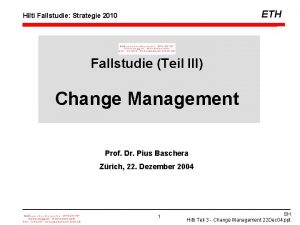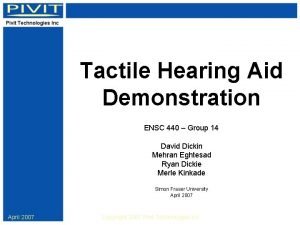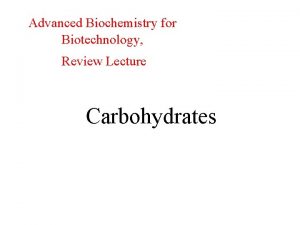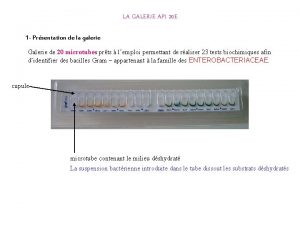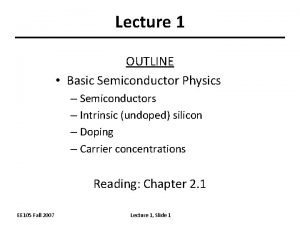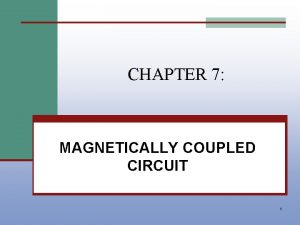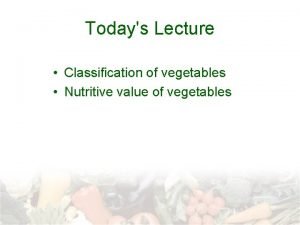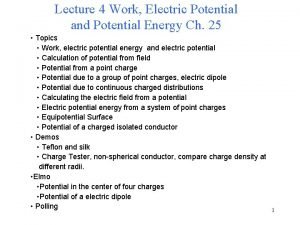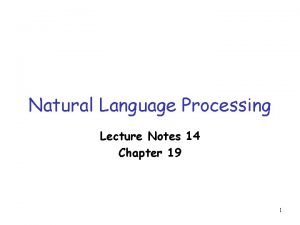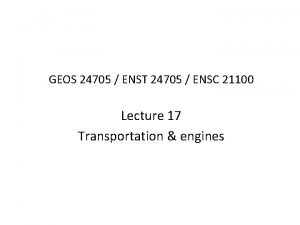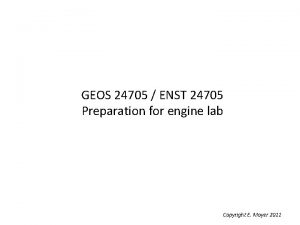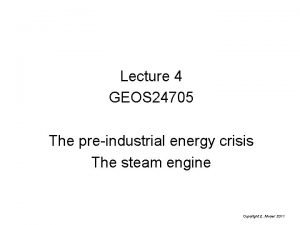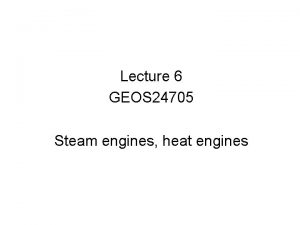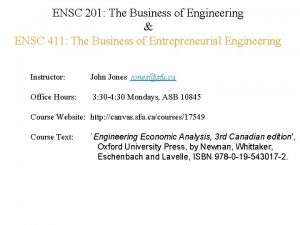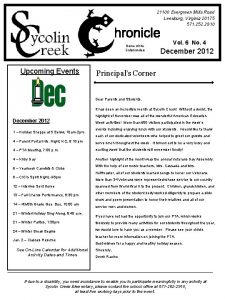GEOS 24705 ENST 24705 ENSC 21100 2018 Lecture















































- Slides: 47

GEOS 24705 / ENST 24705 / ENSC 21100 2018 Lecture 5 Agriculture, History of Energy Use I

Yield growth in agriculture means people now eat more China 1961 From National Geographic: China 2011 https: //www. nationalgeographic. com/what-the-world-eats/

Yield growth in agriculture extends to meat production Chicken now takes only 2 x as much feed as final weight Cows are still ~ x 10, i. e. higher impact food http: //www. nationalchickencouncil. org/about-the-industry/statistics/u-s-broiler-performance/

Innovations mean fewer people needed to farm see also https: //ourworldindata. org/employment -in-agriculture x 10 prod. increase since WWII

History of human energy use

First use of non-human energy relates to food Fire for cooking: definitely 300 -400 K years ago (Homo sapiens and neanderthalensis) potentially 1 M years ago (Homo erectus) Animals for pulling and transportation: 1000 s of years (used first for food, then used for work)

In earliest human history the only “engines” were people Maize farmer, somewhere in Africa, 2007 Source: CIMMYT

In earliest human history the only “engines” were people Ploughing by hand, Uganda

In most of the world, people adopted more powerful “bio-engines” for plowing and planting Diderot & d`Alembert eds, Encyclopédie méthodique. Paris 1763 -1777 & 1783 -87.

Harvesting is a complex motion, difficult to automate Wheat harvest, Hebei Province, China, 2007 (source: www. powerhousemuseum. com)

The combine allowed harvesting to be animal-powered too 27 horsepower! (or perhaps horse+mule-power) Horse drawn combine, likely 1910 s-20 s. Source: FSK Agricultural Photographs

Combine “combines” functions: cuts and threshes grain ~27 horsepower may be practical upper limit Horse-drawn combine, Almira, WA, 1911. W. C. Alexander. Source: U. Wash. library

Rotation: animal powered wheels have a long history First use: grinding Clay millers, W. H. Pyne, London (1806) China, from the encyclopedia “Tiangong Kaiwu”, by Song Yingxing (1637)

Human powered wheels persisted into the modern era Lathe, late 1700 s Japanese water pump, still used in 1950 s Rotational motion is a fundamental industrial need …. Grinding is not the only use of rotational motion.

Other sources of mech. work: wind and water Persian windmill 7 th century (634 -644 AD) or later Energy transformation: kinetic energy Waterwheel 1500 s or earlier

Very early a switch was made from vertical to horizontal axes Pitstone windmill, believed to be the oldest in Britain. Horizontal-axis waterwheel

Pluses & minuses for horizontal axes?

Pluses & minuses for horizontal axes? Plus: * increased efficiency (both wind & water) Minus: * complicated gearing to alter axes * must rotate windmill to match wind dir. Post mill diagram, from The Dutch Windmill, Frederick Stokhuyzen Industrial windmil cogs

What were the needs for mechanical work by mills? anything besides grinding grain?

Why so many windmills along rivers? . . to pump water from the fields Source unknown Luyken, 1694

Pumping can be done with rotational motion alone… Dutch drainage mill using Archimedes’ screw from The Dutch Windmill, Frederick Stokhuyzen

Pumping can be done with rotational motion alone… Bucket chain pumps are seen as early as 700 BC. Common in ancient Egypt, Roman empire, China from 1 st century AD, Medieval Muslim world, Renaissance Europe. Chain pumps, including bucket chain pumps (R) From Cancrinus, via Priester, Michael et al. “Tools for Mining: Techniques and Processes for Small Scale Mining”

Chain pumps need not involve buckets Chain pump cutaway From Lehman’s

…but linear motion allows more efficient pumping Same technology used today in oil wells The lift pump Animation from Scuola Media di Calizzano

First recorded piston pump is in Renaissance Taccola, 1450 Siena, Italy De ingeneis 1433 (Concerning engines) De machinis 1449 (Concerning machines) piston pumps don’t replace bucket chains in England until 1700 s Grindstone, China from the encyclopedia “Tiangong Kaiwu”, by Song Yingxing (1637) reproduction from: Donald Routledge Hill: A history of engineering in classical and medieval times

Linear motions were needed very early in industrial history Chinese bellows, 1313 A. D. European hammer mill w/ cam coupling, 1556 A. D.

The cam converts rotational to linear motion The noncircularity of the cam creates a push at only one part of the cycle The knife-edge cam Animation from the University of Limerick

The cam converts rotational to linear motion The noncircularity of the cam creates a push at only one part of the cycle The rocker arm & camshaft Animation from the University of Limerick

Gears and cams let one wheel drive multiple machines Gold refining, France. D. Diderot & J. Le Rond d`Alembert eds, Encyclopédie méthodique. Paris 1763 -1777 & 1783 -87.

Uses powered by wind & water include: Rotational • Grindstones • Pumps • Winches • Bucket lifts • Spinning wheels • Lathes, borers, drilling machines (first use) Linear (reciprocating) • Hammer-mills • Beaters • Bellows • Saws • Looms Linear (non-reciprocating) • Boats

Uses powered by wind & water include: Rotational • Grindstones • Pumps • Winches • Bucket lifts • Spinning wheels • Lathes, borers, drilling machines (first use) Linear (reciprocating) • Hammer-mills • Beaters • Bellows • Saws • Looms Linear (non-reciprocating) • Boats

Uses powered by wood include Fuel burnt for • Heating • Metallurgy • Glass-making • Brewing (drying the malt) • Baking • Brick-making • Salt-making • Tiles and ceramics • Sugar refining

Uses powered by wood include Fuel burnt for • • • Heating Metallurgy Glass-making Brewing (drying the malt) Baking Brick-making Salt-making Tiles and ceramics Sugar refining

Heating: industrial furnaces grow larger and larger 1500 s Georg Acricola “De res metallica”, Book XII (“Manufacturing salt, soda, alum, vitriol, sulphur, bitumen, and glass”), 1556.

Heating: industrial furnaces grow larger and larger 1700 s Copper foundry, France D. Diderot & J. Le Rond d`Alembert eds, Encyclopédie méthodique. Paris 1763 -1777 & 1783 -87.

The heat-to-work barrier the 18 th century technological impasse All technology involved only two energy conversions • Mechanical motion mechanical motion • Chemical energy heat There was no way to convert chemical energy to motion other than muscles (human or animal) – no engine other than flesh

The end of wood the 18 th century resource crisis

The energy crisis in 1700 s Europe 1700 s “When the fuel situation became difficult in France in the eighteenth century, it was said that a single forge used as much wood as a town the size of Chalon-sur. Marne. Enraged villagers complained of the forges and foundries which devoured the trees of the forests, not even leaving enough for the bakers’ ovens. ” --- F. Braudel, The Structures of Everyday Life, 1979.

The energy crisis hit Britain first 1400 s 1600 “Aeneas Sylvius (afterwards Pope Pius II), who visited Scotland… in the middle of the fifteenth century, mentions …that he saw the poor people who begged at churches going away quite pleased with stones given them for alms. ‘This kind of stone … is burnt instead of wood, of which the country is destitute. ” “Within a few years after the commencement of the seventeenth century the change from wood fuel to coal, for domestic purposes, was general and complete. ” --- R. Galloway, A History of Coal Mining in Great Britain, 1882.

Coal-use in Britain is early 1600 FALSTAFF What is the gross sum that I owe thee? MISTRESS QUICKLY Marry, if thou wert an honest man, thyself and the money too. Thou didst swear to me upon a parcel-gilt goblet, sitting in my Dolphin-chamber, at the round table, by a sea-coal fire, upon Wednesday in Wheeson week, when the prince broke thy head for liking his father to a singing-man of Windsor, thou didst swear to me then, as I washing thy wound, to marry me and make me my lady thy wife. Canst thou deny it? . . . --- W. Shakespeare, Henry IV Part II

Sea-coal: washes up on beach from exposed seams 2013, London Daily Mail: “seacoalers” lose access to beach they have used for centuries

Switch to underground mining as surface exposures are exhausted Children hauling coal from underground mine England 1840 s. Image: the Wellcome Trustees First shaft coal mines in England early 1600 s, common by 1750

Wood coal: changing an energy system Robert Allen, The British Industrial Revolution in Global Perspective

The 2 nd British energy crisis: flooding of the mines 1600 s “The miners, no less than the smelters, had their difficulties during the seventeenth century, but of a totally different kind; for while the latter were suffering from too little fire, the former were embarrassed by too much water… the exhaustion of the coal supply was considered to be already within sight. In 1610, Sir George Selby informed Parliament that the coal mines at Newcastle would not last for the term of their leases of twenty-one years. ” --- R. Galloway, A History of Coal Mining in Great Britain, 1882.

Early complaints about renewables “In the year 1708 a plan was projected in Scotland for draining collieries by means of windmills and pumps. . . one John Young, a millwright of Montrose. . . had been sent to Holland at the expense of the town to inspect the machinery there. . . Wind mills were erected at several collieries, but though they were powerful their action was found to be too intermittent; the mines being drowned and all the workmen thrown idle during long periods of calm weather. ” --- R. Galloway, A History of Coal Mining in Great Britain, 1882.

The 18 th century European energy crisis has 3 parts 1. Fuel became scarce even when only used for heat Wood was insufficient, & coal was getting hard to extract Surface “sea coal” deep-shaft mining below the water table 2. There were limited ways to make motion No way to make motion other than through capturing existing motion or through muscle-power. 3. There was no good way to transport motion Water and wind weren’t necessarily near demand The only means out of the energy crisis was coal – but to mine the coal required motion for pumps.

The revolutionary solution = break the heat work barrier
 Restaurant pro forma income statement
Restaurant pro forma income statement Geos epd
Geos epd Corrective action team
Corrective action team Geos plumbing services
Geos plumbing services Georgia geos
Georgia geos Geos hilti
Geos hilti Ensc 440
Ensc 440 Ensc 351
Ensc 351 Ensc 440
Ensc 440 Ensc platform
Ensc platform 440305
440305 Ensc 428
Ensc 428 01:640:244 lecture notes - lecture 15: plat, idah, farad
01:640:244 lecture notes - lecture 15: plat, idah, farad Que letra continua m v t m j
Que letra continua m v t m j Be 8255
Be 8255 Fuzzy logic lecture
Fuzzy logic lecture Microwave remote sensing lecture notes
Microwave remote sensing lecture notes Lecture metar
Lecture metar Trend lectures
Trend lectures Carbohydrates biochemistry lecture
Carbohydrates biochemistry lecture Nihilism vs existentialism
Nihilism vs existentialism Lecture 8
Lecture 8 Galerie api 20e
Galerie api 20e Othello story summary
Othello story summary Semiconductor lecture
Semiconductor lecture Lecture outline example
Lecture outline example Lecture sound systems
Lecture sound systems Dehiscent vs indehiscent
Dehiscent vs indehiscent Introduction to algorithms lecture notes
Introduction to algorithms lecture notes Othello lecture
Othello lecture Magnetically coupled circuits lecture notes
Magnetically coupled circuits lecture notes Lecture vegetables
Lecture vegetables Electric potential lecture
Electric potential lecture Let+object+verb
Let+object+verb Tegrity lecture capture
Tegrity lecture capture Sargur srihari
Sargur srihari Natural language processing lecture notes
Natural language processing lecture notes Computer security 161 cryptocurrency lecture
Computer security 161 cryptocurrency lecture Ophthalmology lecture
Ophthalmology lecture Les objectifs de la lecture au primaire
Les objectifs de la lecture au primaire Definition of normal flora
Definition of normal flora Les objectifs d'apprentissage de la lecture
Les objectifs d'apprentissage de la lecture Analysis of algorithms lecture notes
Analysis of algorithms lecture notes Hydrology lecture
Hydrology lecture Posterior thorax lecture
Posterior thorax lecture Anesthesia machine lecture
Anesthesia machine lecture Wormhost chest worm locations
Wormhost chest worm locations Stanislas dehaene lecture
Stanislas dehaene lecture





